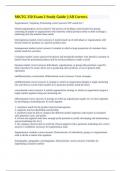MKTG 350 Exam 2 Study Guide || All Correct.
Segmentation, Targeting, Positioning correct answers STP stands for ?
Market segmentation correct answers The process of dividing a total market into groups
consisting of people or organizations with relatively similar product needs in order to design a
marketing mix that matches those needs
heterogeneous market correct answers A market made up of individuals or organizations with
diverse needs for products in a specific product class
homogeneous market correct answers A market in which a large proportion of customers have
similar needs for a product
Consumer market correct answers Purchasers and household members who intend to consume or
benefit from the purchased products and do not buy products to make a profit
business market correct answers Individuals, organizations, or groups that purchase a specific
kind of product for resale, direct use in producing other products, or use in general daily
operations
undifferentiated, concentrated, differentiated correct answers 3 basic strategies
undifferentiated correct answers A strategy in which an organization designs a single marketing
mix and directs it at the entire market for a particular product (used the least)
concentrated correct answers A market segmentation strategy in which an organization targets a
single market segment using one marketing mix
differentiated correct answers A strategy in which an organization targets two or more segments
by developing a marketing mix for each segment
1. customers' needs for the product must be heterogenous
2. segments mist be identifiable and divisible
3. marketers must be able to compare the different market segments with respect to estimated
sales potential, costs, and profits
4. at least one segment must have enough profit potential to justify developing and maintaining a
special marketing mix for it
5. the company must be able to reach the chosen segment with a particular marketing mix correct
answers 5 conditions necessary for segmenting a mark
Segmentation variables correct answers Characteristics of individuals, groups, or organizations
used to divide a market into segments
demographic, geographic, psychographic, behaviorisitic correct answers Variables for
segmenting consumer markets
, demographic correct answers aggregate population characteristics such as the distribution of age
and gender, fertility rates, migration patterns, and mortality rates. Characteristics that marketers
commonly use include age, gender, race, ethnicity, income, education, occupation, family size,
family life cycle, religion, and social class.
geographic correct answers variables—climate, terrain, city size, population density, and
urban/rural areas—also influence consumer product needs.
psychographic correct answers variables, such as personality characteristics, motives, and
lifestyles, to segment markets. Variable can be used by itself or in combination with other types
of segmentation variables
geodemographic correct answers A way of segmenting the market that clusters people by zip
codes or neighborhood units based on lifestyle and demographic information
behavioristic (usage) correct answers Firms can divide a market according to consumer behavior
toward a product, which commonly involves an aspect of product use. Therefore, a market may
be separated into users—classified as heavy, moderate, or light—and nonusers. To satisfy a
specific group, such as heavy users, marketers may create a distinctive product and price or
initiate special promotion and distribution activities. Per capita consumption data help determine
different levels of usage by product category. To satisfy customers who use a product in a certain
way, some feature—packaging, size, texture, or color—may be designed precisely to make the
product easier to use, safer, or more convenient.
Market potential correct answers The total amount of a product that customers will purchase
within a specified period at a specific level of industry-wide marketing activity
company sales potential correct answers The maximum percentage of a market that an individual
firm within an industry can expect to obtain for a specific product
1. Problem Recognition
2. Information Search
3. Alternative Evaluation
4. Purchase
5. Post Purchase correct answers Consumer Decision Process 5 steps
Consumer buying behavior correct answers The decision processes and purchasing activities of
people who purchase products for personal or household use and not for business purposes
Consumer Decision Process correct answers A five-stage purchase decision process that includes
problem recognition, information search, evaluation of alternatives, purchase, and postpurchase
evaluation
Internal search correct answers An information search in which buyers search their memories for
information about products that might solve their problem




